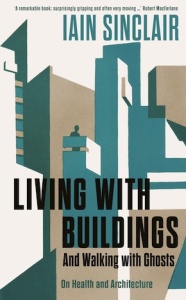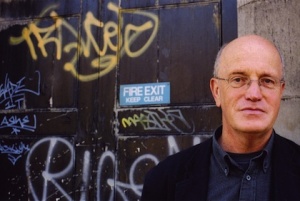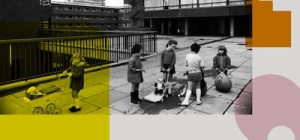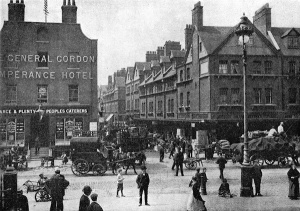Shadows and elevations
by Iain Sinclair
“A remarkable book… at once disorientating and illuminating.” Robert Macfarlane
With his camera and notebook, Jack London circles Hawksmoor’s Christ Church. He does not look up at the portico, the threatening mass of columns, ledges and alcoves. The Mayan dagger of the steeple. He does not step beyond the defensive railings. He stays outside. A photograph from distance, in which men are sprawled, sick or drunk, against the unforgiving hull of blackened stone, and women are upright, still in the game, perky in straw hats against the railings, has a helpful caption: ‘In the Shadow of Christ’s Church, I Saw.’ That apostrophe is a curling finger of blame. A signalled sarcasm. Church without deity. The formidable conceit of this established structure, London suggests, reveals nothing more than an alembic in which to cook the physical ills of the district, to cull the unworthy, the unbelievers. The non-conformists. Christ Church excludes those who have most need of its grudging benevolence.
“Where the shadow falls, all that is mine,” Hawksmoor seems to say. London’s lost ones – those of the city and of the American writer with the same (adopted) name – settle, men and women together, on a circlet of bench around a plane tree in the barren rug of park to the south of the church. The park is a waiting room for sanctioned outpatients, hawking, scratching, but staying in the honest, filthy London air, lungs shredded and cuttlefish black.
Inside Christ Church, down in the crypt, is an oozing mire of Spitalfields corpses, pressing on each other, mulched with rotten wood, foul cerements and linen rags: sad vanities as comforters for a theoretical afterlife. Failed charms against oblivion. London’s outsiders know and fear closing doors, unwelcoming interiors: they stay outside.
“The shadow of Christ’s Church falls across Spitalfields Garden,” Jack London wrote, “and in the shadow of Christ’s Church, at three o’clock in the afternoon, I saw a sight I never wish to see again… Grass only grows here, and it is surrounded by sharp-spiked iron fencing, as are all the parks of London Town, so that homeless men and women may not come in at night and sleep upon it.”

‘In the Shadow of Christ’s Church, I Saw.’ Jack London, The People of the Abyss. Jack London Papers, The Huntington Library, San Marino, California
The American, this squalor tourist, enters Itchy Park like a house surgeon making his brisk ward rounds. “On the benches on either side was arrayed a mass of miserable and distorted humanity… It was a welter of rags and filth, of all manner of loathsome skin diseases, open sores, bruises, grossness, indecency, leering monstrosities, and bestial faces.”
There was no healing sleep in the short, interrupted night. The morning shadow of Hawksmoor’s stone steeple-tree was the call to movement, expulsion from the garden. The sick ones doze. They share their dreams, whatever moments of oblivion they can manage. But it is always safer to be outside. The crypt, in time, will be decanted and scoured, bodies arranged across the floor of the empty church – before the vaulting space can be heritaged, curated, tasked with generating an income stream. Before its malignancy can be exposed in conspiracy comics and blockbuster films. The London sickness, the rough sleepers intuit, is a privilege of architecture: it lodges in churches and hospitals and schools. It lodges in the palaces and mansions and railway suburbs from which they are excluded.
Jack London’s gloss is ugly and eugenicist… Leon Kossoff came at Christ Church from another angle entirely.”
It is “by the portico of Christ’s Church, where the stone pillars rise towards the sky”, and where “whole rows” of men are trying and failing to sleep, that Jack London delivers his verdict. “A lung of London… nay, an abscess, a great putrescent sore.” The visitor to the lower depths can now burn his borrowed clothes. His photographs, faces blurring when the subject turns away, are grounded. They begin with people on the street; with tenements, charity shelters and churches as backdrop, evidence for a polemic.
In the accepted ‘view’ of Spitalfields – a corner of the market as seen from the portico of Christ Church – the seething mass of humanity is frozen: lamp-post lounger, pavement squatter, carter, predestined strider, hands-in-pockets philosopher. And all of them quite oblivious to the General Gordon Temperance Hotel. And to the new building that will replace it. And to the building that will replace the replacement. And to the compulsive façadism of the twenty-first century, where boasted legacy is a curtain of quotations, behind which yet more empty apartments can be assembled for the online property catalogue. And fines paid to cover a shortfall in affordable housing.
Jack London’s gloss is ugly and eugenicist: “A breed strikingly differentiated from their masters’ breed, a pavement folk, as it were, lacking strength and stamina. The men become caricatures of what physical men ought to be, and their women and children are pale and anaemic, with eyes ringed darkly, who stoop and slouch, and are twisted out of all shapeliness and beauty.”
“Deteriorated stock,” he concludes, “left to undergo further deterioration.”
The ultimate metaphor in The People of the Abyss is mulched from the chimney and the ullage cellars of Truman, Hanbury and Buxton, the Quaker brewers, the vanished philanthropists of Brick Lane. “Those that remain are the lees, and they are segregated and steeped in themselves… They have dens and lairs into which to crawl for sleeping purposes, and that is all.”
Our great contemporary painter of this territory, Leon Kossoff, came at Christ Church from another angle entirely. He grew up near Arnold Circus among the reefs of tidy public housing that replaced the Old Nichol rookeries. He stood at the mouth of Fournier Street, and then crouched, to resurrect a child’s awed but responsive strike at the rearing columns. He dignifies the structure as an unstable organic form. A buttery, slithering mass of many mysterious apertures but no point of entry. Kossoff does not stray into the fenced garden. He makes his preliminary drawings – stupendous dashes, diagnostic marks, whipping lines of charcoal and chalk, the firm vertical strokes of the Tuscan columns challenged by zigzag hatchings – from the north side, as he comes down, once more, from his childhood home. These drawings are heroic captures from the tumble of a frail craft about to be dashed against stupendous rocks, or swept headlong into the wash of Fournier Street. The hieratic building, a fanciful history of architecture in one stack, period lofted on period, sways at anchor. And sheers away from the witness. The tip of a stone mast before the raft of vision is overwhelmed.
Paul Moorhouse in his Tate Gallery publication, Leon Kossoff (1996), says that the painter’s enthusiasm for the motif, after previous struggles, was rekindled by a reading of Hawksmoor, the Peter Ackroyd novel published in 1985. Kossoff has spoken of how Arnold Circus looked and felt, on one August day of dusty sunlight. It was “like the London of Blake’s Jerusalem”. The abnegation to place and the plurality of time manifests as a psychic seizure: “The urgency that drives me to work is not only to do with the pressures of the accumulation of memories and the unique quality of the subject on this particular day but also with the awareness that time is short.” And not just, as the painter implies, for a London threatened by the presumption of City towers, but for his own health and strength. The area’s continued resistance is encoded in the thrust of Christ Church’s spectacular elevation. “It is by its monumental flight into unimpeded space that we remember this building.”
from ‘Christ Church: The Sickness and the Shadow’ in Living With Buildings – And Walking with Ghosts (Profile Books/Wellcome Collection, £14.99)
 Iain Sinclair was born in South Wales, went to school in the west of England and to university in Dublin. He lives, walks and writes in East London. His books include Downriver (winner of the James Tait Black Memorial Prize and the Encore Prize), Lights Out for the Territory, London Orbital, Hackney, That Rose-Red Empire, American Smoke and The Last London. Living with Buildings is published in hardback and eBook by Profile Books in association with Wellcome Collection, in response to the exhibition of the same name running from 4 October 2018 to 3 March 2019. Read more
Iain Sinclair was born in South Wales, went to school in the west of England and to university in Dublin. He lives, walks and writes in East London. His books include Downriver (winner of the James Tait Black Memorial Prize and the Encore Prize), Lights Out for the Territory, London Orbital, Hackney, That Rose-Red Empire, American Smoke and The Last London. Living with Buildings is published in hardback and eBook by Profile Books in association with Wellcome Collection, in response to the exhibition of the same name running from 4 October 2018 to 3 March 2019. Read more
iainsinclair.org.uk
Author portrait © Joy Gordon
Living With Buildings exhibition
4 October to 3 March
Wellcome Collection, 183 Euston Road, London NW1 2BE
Tuesday to Saturday 10am to 6pm; Thursday 8pm
Sunday 11 am to 6 pm
Free admission
 How does our built environment affect us? This major exhibition about health and architecture examines the positive and negative influence buildings have on our physical and mental health. From the slums of 19th-century London to the bold experiments of postwar urban planners to therapeutic spaces for people affected by cancer, look anew at the buildings that surround us and shape us.
How does our built environment affect us? This major exhibition about health and architecture examines the positive and negative influence buildings have on our physical and mental health. From the slums of 19th-century London to the bold experiments of postwar urban planners to therapeutic spaces for people affected by cancer, look anew at the buildings that surround us and shape us.
The exhibition includes works by Andreas Gursky, Rachel Whiteread and Martha Rosler, buildings designed by Lubetkin, Goldfinger and Aalto, and a new commission by artist Giles Round exploring the role colour can play in making us feel better.
More info



